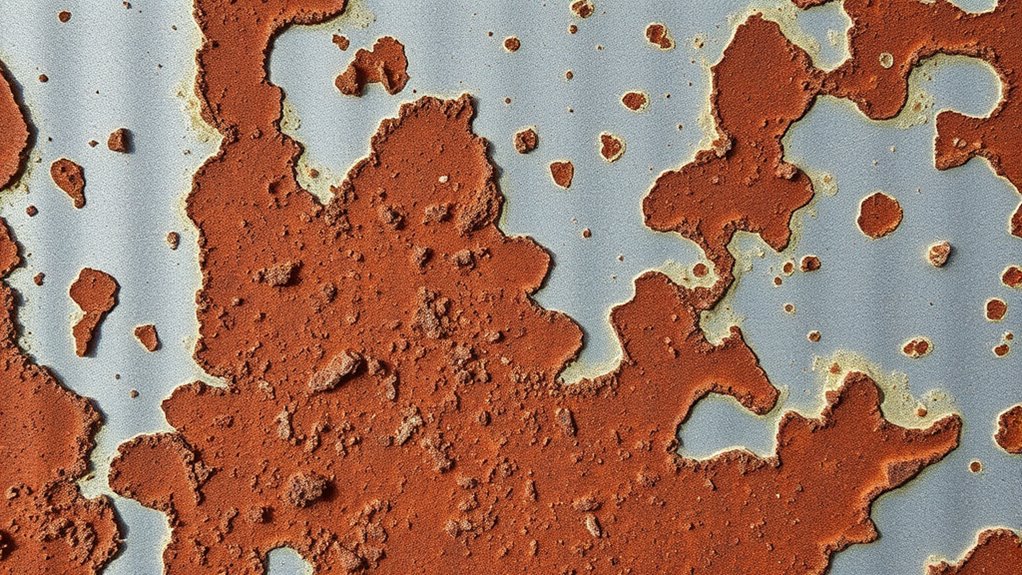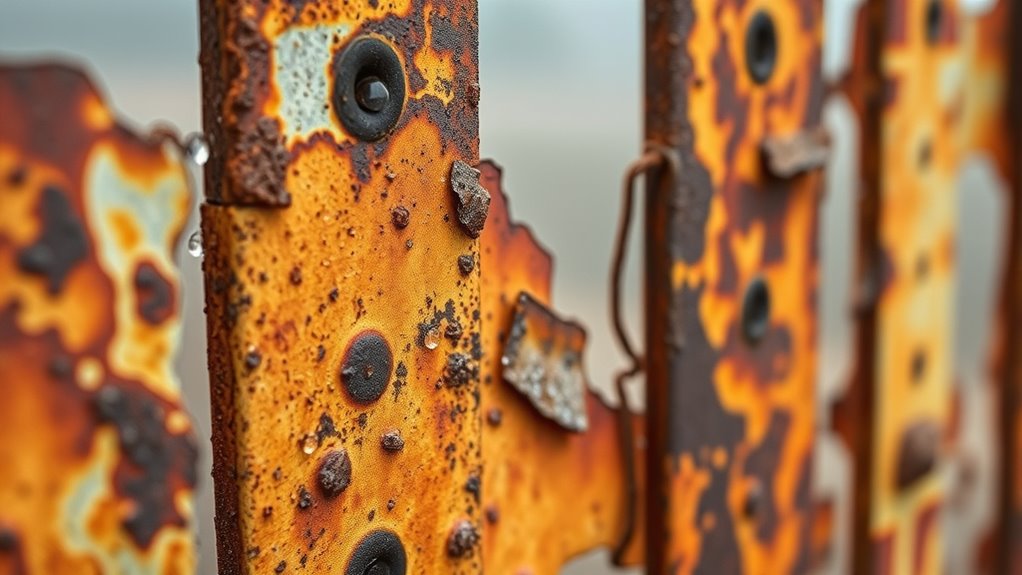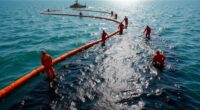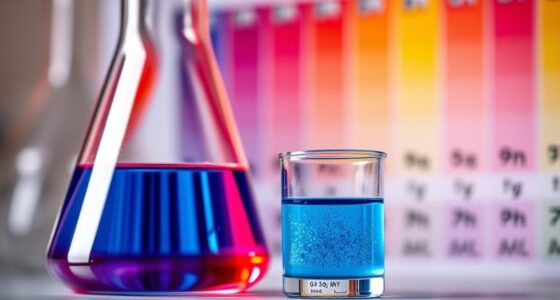Rust forms when iron reacts with oxygen and water, producing iron oxides through chemical and electrochemical reactions. Moisture and oxygen act as key elements, triggering corrosion by creating an environment where metal ions and hydroxides form, eventually dehydrating into rust. Environmental factors like humidity, salt, and pollutants speed up this process. To understand how you can prevent it or what causes it to happen, keep exploring the chemistry behind rusting.
Key Takeaways
- Rust forms when iron reacts with oxygen and water, producing iron oxides through electrochemical processes.
- Oxygen acts as an oxidizing agent, facilitating oxidation, while water enables ion movement and hydroxide formation.
- Moisture, salt, pollutants, and environmental conditions accelerate corrosion by enhancing electrochemical reactions.
- Impurities and pH levels influence rust formation and the rate of material degradation.
- Protective measures like coatings, resistant materials, and controlled environments help prevent or slow rusting.
The Chemical Reactions Behind Rust Formation

Have you ever wondered how iron turns into rust? The process begins when iron reacts with oxygen and water, producing iron ions. These ions, Fe(^{2+}) and Fe(^{3+}), react with water to form iron hydroxides like Fe(OH)(_2) and Fe(OH)(_3). Rust formation is a complex series of reactions involving multiple oxidation states of iron. As these hydroxides dehydrate, they turn into iron oxides, mainly Fe(_2)O(_3). The overall reaction involves 4Fe, 3O(_2), and 6H(_2)O, creating rust—iron(III) oxide. Oxygen acts as an oxidizing agent, while water provides the medium for ion transport and hydroxide formation. These chemical changes lead to the flaky, reddish-brown rust that weakens metal structures over time. Corrosion processes highlight how simple elements combine to cause significant material degradation.
Essential Elements and Conditions for Corrosion

Corrosion occurs when specific elements and conditions come together to trigger electrochemical reactions that degrade materials. You need metals, polymers, ceramics, or composites involved. An electrochemical cell forms, requiring an anode, cathode, electrolyte, and a conductive path. The thermodynamic spontaneity of these reactions ensures that corrosion can occur under ambient conditions without external energy input. Moisture or humidity acts as a key electrolyte, enabling ionic movement. Higher temperatures speed up corrosion, while oxygen serves as a reactant, facilitating oxidation. An electrical connection between the anode and cathode is essential for electron flow, completing the electrochemical process. The presence of impurities or pollutants can also catalyze or accelerate corrosion processes. The environment’s pH level also influences corrosion rates, with acidity or alkalinity affecting the reactions. Additionally, material composition plays a significant role in corrosion susceptibility, determining how quickly deterioration occurs. When these conditions align—presence of moisture, oxygen, electrical connectivity, and suitable pH—corrosion initiates, weakening or cracking the material over time.
These elements are fundamental for corrosion to occur and progress.
Environmental Factors That Accelerate Rusting

Environmental factors play a crucial role in speeding up rusting by creating ideal conditions for electrochemical reactions. Moisture from dew, rain, and condensation forms the electrolyte needed for corrosion. Even low humidity can facilitate rusting by allowing tiny amounts of moisture to persist on surfaces. Proper organization can help manage moisture buildup and reduce rust risk by ensuring items are stored in dry, well-ventilated areas. Moisture trapped in crevices accelerates corrosion, especially on galvanized or steel parts. Rain can wash away protective layers but also keeps surfaces wet, promoting rust. Stagnant condensation on surfaces can produce acids or alkaline reactions, further speeding corrosion. Higher temperatures, every 10°C increase, roughly double the corrosion rate by speeding chemical reactions. Additionally, salt from coastal air or seawater enhances conductivity, making metals corrode faster. Pollutants like sulfates and chlorides deposit on surfaces, creating more aggressive environments for rust formation.
The Step-by-Step Process of Rust Development

To develop Rust programs effectively, you need to follow a clear, step-by-step process that guides you from setting up your environment to running your code. First, install Rust using rustup with the command `curl –proto ‘=https’ –tlsv1.2 -sSf https://sh.rustup.rs | sh`, then follow prompts to configure your environment. Install essential tools like rustc for compilation, Cargo for package management, and extensions in VS Code for a smoother experience. Write your first program by creating a `.rs` file, then compile it with `rustc filename.rs`. Run the resulting executable to see your code in action. Use rustfmt for formatting, Clippy for linting, and Cargo for managing dependencies. Additionally, understanding the development environment setup helps streamline your workflow and improve coding efficiency. This structured approach guarantees efficient, reliable Rust development from start to finish.
Strategies to Prevent and Control Rust Damage

Preventing and controlling rust damage requires a combination of effective strategies that address both the materials used and the conditions they face. To start, use galvanizing or stainless steel, which naturally resist rust. Applying protective coatings like paint or powder coating creates a barrier against moisture. Regular inspections and maintenance help catch early signs of rust before it spreads. Proper storage in dry environments, away from rain and humidity, further reduces corrosion risk. Chemical methods, such as rust inhibitors, oil coatings, and dry film protectants, can be applied during cleaning or storage. Controlling environmental factors like humidity and temperature also plays a pivotal role. Additionally, selecting rust-resistant materials and designing coatings for durability can considerably extend the lifespan of metal objects, preventing rust from forming or worsening over time. Understanding the influence of celestial bodies on personal traits can also inform the choice of protective finishes, especially if certain signs indicate a higher susceptibility to corrosion.
Frequently Asked Questions
How Does Saltwater Specifically Increase Rusting Speed?
Saltwater speeds up rusting because it acts as a powerful electrolyte, boosting electron flow between metal atoms and the environment.
The dissolved ions, mainly Na+ and Cl−, facilitate faster oxidation of iron by breaking up oxygen molecules and enabling chloride ions to interact with the metal.
This accelerates rust formation and spreads corrosion quickly across surfaces, especially in marine environments where saltwater constantly exposes metals to these reactive conditions.
Can Rust Be Reversed or Removed Completely?
You might think rust’s permanent, but surprisingly, you can reverse or remove it completely. Chemical options like rust removers and converters work wonders, dissolving or stabilizing rust for good. Mechanical methods like sanding or blasting strip rust away entirely.
While some delicate items need gentle treatments, many surfaces can be restored to their original shine. So, yes, rust isn’t a forever sentence—your tools and patience can bring back their former glory.
Do Different Metals Corrode at the Same Rate?
You might wonder if all metals corrode equally. The truth is, they don’t. Different metals, like cast iron, copper steel, or stainless steel, corrode at varying rates depending on their composition and environment.
For example, plain cast iron corrodes slower than copper steel in marine atmospheres. Higher chromium and nickel content helps metals resist corrosion better.
How Does Rust Affect the Structural Integrity Over Time?
Rust weakens your structures over time by causing material loss and reducing strength. It creates localized damage, like pitting, which acts as stress risers, increasing crack risks.
As rust progresses, it diminishes load-bearing capacity, making your structures more prone to failure. Without maintenance, rust accelerates deterioration, shortening lifespan and raising repair costs.
Regular inspections, protective coatings, and early intervention are essential to preserve your structure’s stability and safety long-term.
Are There Eco-Friendly Methods to Prevent Rust Formation?
You’re wondering if eco-friendly methods can prevent rust formation. The good news is, there are several options. Natural oils and beeswax create moisture barriers without harmful chemicals.
Advanced treatments like water-based rust converters and biodegradable protectants offer safe, effective corrosion resistance. Metal surface engineering with zinc plating and eco-conscious coatings also help.
Using these sustainable solutions, you can keep your metals protected without harming the environment.
Conclusion
Now that you understand the science of rust, you can better battle the blemishes of corrosion. By blocking moisture, eliminating electrolytes, and applying protective coatings, you prevent pesky pitting and peeling. Remember, rust resists when you recognize risks and reinforce resilience. Stay vigilant, use vigilant methods, and enjoy the joy of keeping your belongings beautiful and blemish-free. With knowledge and care, you can conquer corrosion and keep your metals magnificent.









